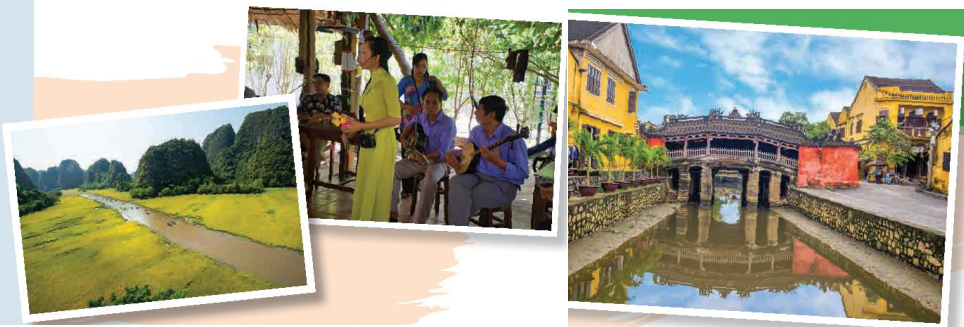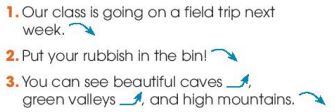Giải SGK, SBT Unit 6. Preserving our heritage Global Success
Giải SGK, SBT Unit 6 Global Success
2. Where can we do the following? Write T for Trang An, H for Hoi An, and M for Mekong River Delta.
(Chúng ta có thể làm những điều sau đây ở đâu? Viết T cho Tràng An, H cho Hội An, và M cho Đồng bằng sông Cửu Long.)
|
Activity |
Place |
|
1. Going on a tour by boat |
|
|
2. Seeing areas of natural beauty |
|
|
3. Seeing ancient houses kept in their original style of architecture |
|
|
4. Listening to don ca tai tu at floating markets |
|
3. Match the words to make phrases used in 1.
(Nối các từ để tạo thành các cụm từ được sử dụng trong 1.)
|
1. folk |
a. architecture |
|
2. cultural |
b. landscape |
|
3. beautiful |
c. singing |
|
4. ancient |
d. heritage |
Our heritage (Di sản của chúng ta)
1. Match the words with their meanings.
(Nối các từ với ý nghĩa của chúng.)
|
1. restore (v) |
a. connected with things from the past |
|
2. historical (adj) |
b. traditional to a particular group or country, and usually passed down from generation to generation |
|
3. preserve (v) |
c. important in history |
|
4. folk (adj) |
d. to return something to an earlier good condition or position |
|
5. historic (adj) |
e. to keep something in its original state or in good condition and prevent it from being damaged |
4. Read the article again and decide which paragraph includes the following information.
(Đọc bài viết một lần nữa và quyết định đoạn nào bao gồm các thông tin sau.)
|
|
Paragraph |
|
1. Creating popular topics on the Internet such as sharing postcards |
A |
|
2. Raising awareness of preserving our heritage through discussions |
|
|
3. Organising photo competitions on social media |
|
|
4. Setting up local historical societies to organise festivals and other events |
|
|
5. Inviting artists to perform and teach folk singing, dancing and music |
|
Preserving cultural heritage (Giữ gìn di sản văn hóa)
1. Work in pairs. Match the ways to preserve our heritage with the reasons for doing so.
(Làm việc theo cặp. Nối những cách để bảo tồn di sản của chúng ta với những lý do để làm như vậy.)
|
Ways |
Reasons |
|
1. Learning about cultural heritage at school |
a. Spreading information to more people quickly |
|
2. Promoting cultural heritage on social media |
b. Helping students understand the value of cultural heritage |
|
3. Organising competitions to find good ideas for preserving our heritage |
c. Making cultural heritage more widely known to people around the world |
|
4. Introducing cultural heritage to foreign visitors through tourism activities |
d. Encouraging people to get more involved |
2. Complete the conversation with the words and phrases in the box. Then practise It in pairs.
(Hoàn thành đoạn hội thoại với các từ và cụm từ trong hộp. Sau đó thực hành Nó theo cặp.)
|
A. Well (Vâng) B. Right (Đúng) C. Really (Thật đấy) D. Let me think (Để tôi suy nghĩ) |
Nam: What do you think is the best way to preserve cultural heritage?
Anna: (1) _____________. The best way to preserve it is to raise people’s awareness of its importance.
Nam: (2) _____________. We can set up school jobs for students to learn about forms of cultural heritage, such as folk music, singing, or dancing.
Anna: (3) ____________, our classmates will show no interest in such clubs.
Nam: (4) ____________? Why do you think so?
Anna: Traditional arts are not fashionable. There are so many other exciting things for us to do.
Nam: That's why it’s important to make such clubs more interesting for teenagers.
A leaflet about ways to preserve Trang An Scenic Landscape Complex
(Một tờ rơi về các biện pháp giữ gìn Quần thể danh thắng Tràng An)
1. Work in pairs. Put the problems that Trang An Scenic Landscape Complex may face and the possible solutions in the correct blanks.
(Làm việc theo cặp. Đặt các vấn đề mà Quần thể danh thắng Tràng An có thể gặp phải và các giải pháp khả thi vào chỗ trống.)
A. educating young people about the importance of heritage
(giáo dục giới trẻ về tầm quan trọng của di sản)
B. damaging the ecosystem
(hủy hoại hệ sinh thái)
C. loss of cultural values
(mất giá trị văn hóa)
D. organising eco-tours to natural heritage sites
(tổ chức du lịch sinh thái đến các di sản thiên nhiên)
|
NATURAL HERITAGE |
CULTURAL HERITAGE |
|
Problems: Negative effects of mass tourism - polluting the rivers and valleys - ____________________________ Solutions: - (2) ___________________________ - creating a sustainable habitat suitable for local wildlife |
Problems: Young people's lack of knowledge about the cultural heritage - not able to appreciate traditions - (3) _____________________________ Solutions: - (4) _____________________________ - promoting heritage values on social media |














